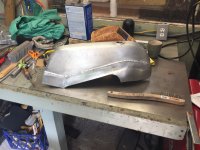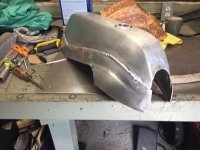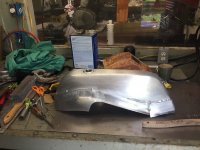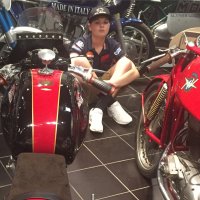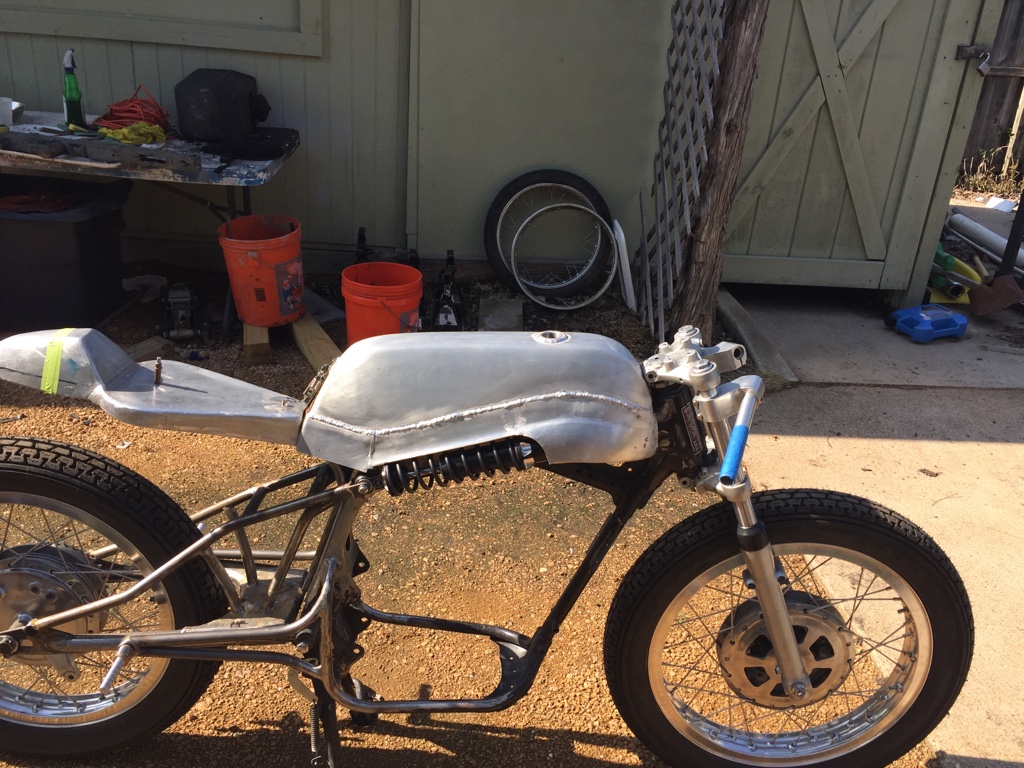We noticed you are blocking ads. DO THE TON only works with community supporters. Most are active members of the site with small businesses. Please consider disabling your ad blocking tool and checking out the businesses that help keep our site up and free.
You are using an out of date browser. It may not display this or other websites correctly.
You should upgrade or use an alternative browser.
You should upgrade or use an alternative browser.
Zoöid Third Times a Charm CB175
- Thread starter Texasstar
- Start date
Texasstar
Can't is a four letter dirty word
i think that .9173" /71.883 lbs is at max cam lift. Our coil bind on our other springs is around .62"crazypj said:71.883lbs is coil bind height or fitted height? (23.3mm ~ 0.917")
If fitted height, your math is correct from actual measurements
This is where a spring tester is handy, you just measure at instralled height, full open height and compare whatever you have as race part (plus keep notes of everything so you know when springs weaken.)
Quick and dirty method.
Put two different springs you don't know spec end to end with a washer in between, squash down in vice or press to installed height for stock spring, measure the other spring. If it's longer than installed height, it's probably stiffer spring. Next, squash down to max open height for stock spring, compare the other spring. It should be way above length of stock.
It's actually way quicker to check than it is to type out
Texasstar
Can't is a four letter dirty word
We took the stock 160 and 175 springs, seats, and retainers to wells racing to use their computer spring tester.
CB 160 stock valve springs
1.17" installed height 48#
.270" lift 75#
CB 175 stock springs
1.17" installed 25#
.275" lift 100#
Sent from my iPhone using Tapatalk
CB 160 stock valve springs
1.17" installed height 48#
.270" lift 75#
CB 175 stock springs
1.17" installed 25#
.275" lift 100#
Sent from my iPhone using Tapatalk
Texasstar
Can't is a four letter dirty word
is this correct? We want to compare the aftermarket lift to the stock lift of the 175 which is .244 or .9173" that is in the manual. Most aftermarket race proven springs for the 160/170 are giving lift pressures at .354 - .40" lift. For example the KPMI is 123lbs@.354". So if we divide the 123 by .354 and multiply it by .244" we would end up with the equivalent lift pressure which is 84.77lbs @.244" lift for the KPMI valve springs.
The stock 175 is 98.54lbs at .244" lift. We confirmed that the 175 stock spring is 100#@.275" lift.
If that is correct the KPMI has less pressure than the stock 175 leaving us with other questions. Is valve float mainly caused by resonance? Is KPMI springs making an assumption that the max rpm for the 175 will remain the stock rpm? Why in the heck would we buy KPMI springs to replace the stock springs? (The resonance data for the KPMI springs is not available.)
The stock 175 is 98.54lbs at .244" lift. We confirmed that the 175 stock spring is 100#@.275" lift.
If that is correct the KPMI has less pressure than the stock 175 leaving us with other questions. Is valve float mainly caused by resonance? Is KPMI springs making an assumption that the max rpm for the 175 will remain the stock rpm? Why in the heck would we buy KPMI springs to replace the stock springs? (The resonance data for the KPMI springs is not available.)
Yes, resonance is mainly a function of the natural frequency of the springs. The idea behind well designed springs is to make them so they resonate at a frequency that the engine spends little time at.
A bigger issue is how to damp out resonance. The first way is with two springs of different frequency. Then wind the inner and outer in different directions and have a slight interference fit between them. That really helps to damp out float. A trick that Norris used years ago was to add a third spring. It was falt and acted as interference between the two real springs.
The final technique available in normal springs is to make the springs stronger/stiffer to raise the natural frequency to way above the revs that the motor could reach. Stock Honda springs used to be barely stiff enough and as the were used they lose height and stifness and valve float occurs at lower that stock revs.
Then there are so called beehive springs and progressively wound springs which are all ways to change the natural frequency. And the lighter the parts are, the less momentum that has to be reversed in each cycle.
What you want is the lowest seat pressure and lightest spring and cap set that minimizes wear on cams and rockers etc but in a spring set that contains float.
A bigger issue is how to damp out resonance. The first way is with two springs of different frequency. Then wind the inner and outer in different directions and have a slight interference fit between them. That really helps to damp out float. A trick that Norris used years ago was to add a third spring. It was falt and acted as interference between the two real springs.
The final technique available in normal springs is to make the springs stronger/stiffer to raise the natural frequency to way above the revs that the motor could reach. Stock Honda springs used to be barely stiff enough and as the were used they lose height and stifness and valve float occurs at lower that stock revs.
Then there are so called beehive springs and progressively wound springs which are all ways to change the natural frequency. And the lighter the parts are, the less momentum that has to be reversed in each cycle.
What you want is the lowest seat pressure and lightest spring and cap set that minimizes wear on cams and rockers etc but in a spring set that contains float.
Texasstar
Can't is a four letter dirty word
Thank you Teazer! Back to the "optimization" word. So the question is how brave are we? Do we try the mx101 Yamaha yz250f pac racing single spring? The resonance is good to 14k with 144# per inch spring rate. So the seat rate is 33lbs the coil bind is fine and the weight is the lightest but is only 71lbs at .270" lift. We may need to go to lighter valves...teazer said:Yes, resonance is mainly a function of the natural frequency of the springs. The idea behind well designed springs is to make them so they resonate at a frequency that the engine spends little time at.
A bigger issue is how to damp out resonance. The first way is with two springs of different frequency. Then wind the inner and outer in different directions and have a slight interference fit between them. That really helps to damp out float. A trick that Norris used years ago was to add a third spring. It was falt and acted as interference between the two real springs.
The final technique available in normal springs is to make the springs stronger/stiffer to raise the natural frequency to way above the revs that the motor could reach. Stock Honda springs used to be barely stiff enough and as the were used they lose height and stifness and valve float occurs at lower that stock revs.
Then there are so called beehive springs and progressively wound springs which are all ways to change the natural frequency. And the lighter the parts are, the less momentum that has to be reversed in each cycle.
What you want is the lowest seat pressure and lightest spring and cap set that minimizes wear on cams and rockers etc but in a spring set that contains float.
And there you have it. How much are Ti valves anyway? Just be wary that they are best suited to a design with cam over a bucket with linear valve motion. They have a tendency to gall in a rocker type design because of the side thrusts.
There's a lot of weight in the head of stock Honda 2 piece (spun welded) valves. Try new Stainless valves with flatter heads. The shape is not as good for flow but you can get most of that back and even with slightly lower V.E. you MAY be able to get more revs out of it if you control cam chain flap. And a 180 crank would help there too.
It's only money. Right? And as long as it's yours we are thinking of spending and not mine, I'm OK with that. ;-)
There's a lot of weight in the head of stock Honda 2 piece (spun welded) valves. Try new Stainless valves with flatter heads. The shape is not as good for flow but you can get most of that back and even with slightly lower V.E. you MAY be able to get more revs out of it if you control cam chain flap. And a 180 crank would help there too.
It's only money. Right? And as long as it's yours we are thinking of spending and not mine, I'm OK with that. ;-)
crazypj
Split personality, I fake being smart
teazer said:It's only money. Right? And as long as it's yours we are thinking of spending and not mine, I'm OK with that. ;-)
LOL ;D
In my opinion, beehive springs are the greatest single innovation of probably last 50 yrs
Major problem will be finding them small enough to fit into 200 motor.
You probably need to switch to different valve guide material with titanium or stainless steel valves, both materials have pretty poor scuff resistance
Texasstar
Can't is a four letter dirty word
Agreed lol and you can't take it with you! However you can lose half if you don't keep the misses happyteazer said:And a 180 crank would help there too.
It's only money. Right? And as long as it's yours we are thinking of spending and not mine, I'm OK with that. ;-)
I like stock Honda valve guides. The seem to retain oil in the "pores". Ti tends to stick though, so you need bronze guides or something more sexy. Stainless I ran for years in my CB77. They were machined for me from some auto blanks and with a flatter head and larger than stock they were much lighter and the motor revved much higher than most of its kind.
They used to end up all dented on the tips though. I had one set stellite tipped and that wasn't a huge success. What they need are either flat foot valve adjusters (heavy) or valve caps (almost as heavy). I always lighten the rocker arms, fit Al or Ti adjuster nuts and where possible drill the screws out and have them broached to take a small allen wrench. All to same a few grams.
Back in the early sixties Pops Yoshimura was racing CB72s and 77s and he experimented with valve weights and lighter is better. See if you can find a copy of the old Yosh article on tuning those Hondas.
They used to end up all dented on the tips though. I had one set stellite tipped and that wasn't a huge success. What they need are either flat foot valve adjusters (heavy) or valve caps (almost as heavy). I always lighten the rocker arms, fit Al or Ti adjuster nuts and where possible drill the screws out and have them broached to take a small allen wrench. All to same a few grams.
Back in the early sixties Pops Yoshimura was racing CB72s and 77s and he experimented with valve weights and lighter is better. See if you can find a copy of the old Yosh article on tuning those Hondas.
Texasstar
Can't is a four letter dirty word
Will do! What do you think about the Mikuni TM 24mm flatsides for this build?teazer said:I like stock Honda valve guides. The seem to retain oil in the "pores". Ti tends to stick though, so you need bronze guides or something more sexy. Stainless I ran for years in my CB77. They were machined for me from some auto blanks and with a flatter head and larger than stock they were much lighter and the motor revved much higher than most of its kind.
They used to end up all dented on the tips though. I had one set stellite tipped and that wasn't a huge success. What they need are either flat foot valve adjusters (heavy) or valve caps (almost as heavy). I always lighten the rocker arms, fit Al or Ti adjuster nuts and where possible drill the screws out and have them broached to take a small allen wrench. All to same a few grams.
See if you can find a copy of the old Yosh article on tuning those Hondas.
Texasstar
Can't is a four letter dirty word
Texasstar
Can't is a four letter dirty word
I have an email into RD because I think their first spring on their beehive data chart is wrong for the open lift. Keep your fingers crossed! If it is 170lbs and not 70lbs then we should be in the money. If you compare that springs data with the other springs that number doesn't make sense.crazypj said:LOL ;D
In my opinion, beehive springs are the greatest single innovation of probably last 50 yr
Sent from my iPhone using Tapatalk
Texasstar
Can't is a four letter dirty word
Nope Zach said that beehive was for a Yamaha with titanium valves...so I called the other spring manufactures and begged them to build one. PAC Racings r and d said that the lawnmower racing guys have been asking for one also. I told them well why in the heck haven't you built one yet? 
Sent from my iPhone using Tapatalk
Sent from my iPhone using Tapatalk


